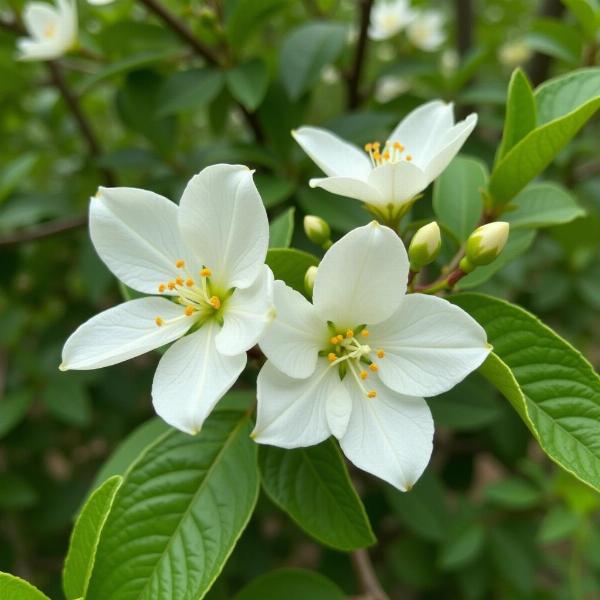Privet, a common hedging plant, doesn’t have a direct, widely-used Hindi equivalent. This often leads to confusion when translating texts or discussing gardening in Hindi. This article delves into the nuances of expressing the concept of “privet” in Hindi, exploring various options, cultural contexts, and practical translation strategies.
Understanding the Challenges of Translating “Privet”
The lack of a single, universally accepted Hindi word for “privet” stems from several factors. Firstly, the plant itself isn’t traditionally native to many parts of India. While some privet species are cultivated, they haven’t deeply ingrained themselves into the local lexicon like native flora. Secondly, Hindi, like many languages, often employs descriptive phrases rather than single words for specific plant varieties. This reflects a nuanced understanding of the plant’s characteristics and uses. So, how do we bridge this linguistic gap?
Describing Privet in Hindi: Practical Approaches
Several strategies can effectively convey the meaning of “privet” in Hindi. One approach is using the scientific name, Ligustrum, often transliterated as लिगस्ट्रम (ligastram). While scientifically accurate, this might not be easily understood by everyone. A more accessible method involves descriptive phrases, highlighting key characteristics of privet, such as its use as a hedge. For example, मेढ़ की झाड़ी (medh ki jhadi), meaning “hedge bush,” provides a general understanding. Adding details like सदाबहार मेढ़ की झाड़ी (sadabahar medh ki jhadi), meaning “evergreen hedge bush,” further clarifies the plant’s nature.
Regional Variations and Local Names
Adding to the complexity, privet might have specific local names in regions where it’s more commonly grown. These regional variations reflect the intimate connection between language and local ecology. Researching and incorporating these local terms can provide a more nuanced and culturally sensitive translation.
 Privet Flowers Close-Up
Privet Flowers Close-Up
Privet in Indian Gardens: Cultural Context
While not as deeply rooted as native plants, privet has found its place in some Indian gardens, particularly in urban landscapes and formal gardens. Its dense foliage makes it an ideal choice for hedges, providing privacy and a touch of greenery. This practical application is often reflected in the Hindi descriptions used for the plant.
Translating “Privet” in Different Contexts
The best translation for “privet” depends heavily on the context. In scientific literature, using the scientific name Ligustrum is appropriate. In informal conversations, descriptive phrases like “hedge bush” suffice. For gardening manuals, a combination of descriptive phrases and potentially local names might be the most effective approach.
What if I’m talking about Privet tea?
Interestingly, while the privet plant itself might not have a direct Hindi equivalent, privet tea, made from the leaves of Chinese privet (Ligustrum sinense), is sometimes referred to as नीम की पत्तियों वाली चाय (neem ki pattiyon wali chai) due to the leaves’ resemblance to neem leaves. However, this is not accurate and it’s important to clarify that it is not neem tea but a separate plant.
Conclusion: Finding the Right Words for “Privet” in Hindi
While a single, perfect Hindi equivalent for “privet” remains elusive, understanding the nuances of the language and the plant’s cultural context allows for effective communication. By employing descriptive phrases, considering regional variations, and adapting to the specific context, we can accurately convey the meaning of “privet” in Hindi. This approach not only bridges a linguistic gap but also reflects a deeper appreciation for the interplay between language, culture, and the natural world.
FAQ
- What is the exact Hindi word for privet? There isn’t one single, universally accepted word.
- How can I describe privet in Hindi? Use descriptive phrases like मेढ़ की झाड़ी (medh ki jhadi) or the scientific name लिगस्ट्रम (ligastram).
- Are there regional variations for the name of privet in India? Yes, local names might exist in areas where it’s cultivated.
- What is the best way to translate “privet” in a scientific context? Use the scientific name Ligustrum.
- How do I refer to privet when talking about gardening in Hindi? Descriptive phrases like “hedge bush” are generally understood.
- Is privet tea the same as neem tea? No, they are derived from different plants, although their leaves might look similar.
- Where can I find more information about Indian plants and their names? Botanical gardens and local nurseries can be valuable resources.
Meaning-Hindi.in is your trusted partner for accurate and culturally sensitive Hindi translations. We specialize in various translation services, including business and commercial documents, legal and certified translations, technical manuals, website localization, educational materials, and specialized content. Our expertise in Hindi language and culture ensures precise and contextually appropriate translations. Need help with your Hindi translation project? Contact us at [email protected] or call us at +91 11-4502-7584. Meaning-Hindi.in is committed to delivering high-quality translations that bridge linguistic and cultural divides.